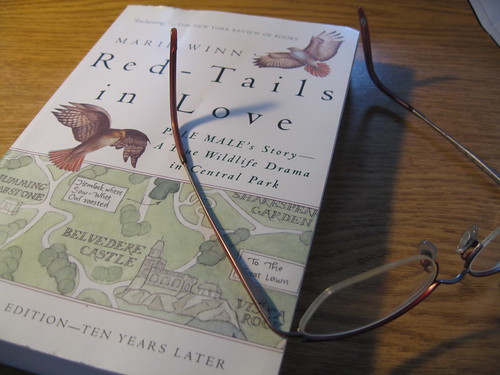 My friend Sue Wolff generously lent me two books recently. The first, Marie Winn’s “Red-Tails in Love” captured my heart and mind. It is the story of a community of birdwatchers in Central Park in New York City and how they observed, loved and obsessed over a family of Red-Tailed Hawks that raised a family on an apartment ledge just of Central Park.
My friend Sue Wolff generously lent me two books recently. The first, Marie Winn’s “Red-Tails in Love” captured my heart and mind. It is the story of a community of birdwatchers in Central Park in New York City and how they observed, loved and obsessed over a family of Red-Tailed Hawks that raised a family on an apartment ledge just of Central Park.
If you have ever hankered to read a “real life” story about an organic community of practice, one free from the business pressures of CoPs manufactured inside of corporations, read this book. The narrative is compelling, but the lessons about community life are at once simple, effective and profound.
I thought it might be fun to look at this community, as best an outsider can do (which is usually not very well) from one of the CoP perspectives Etienne Wenger, John Smith and I use in our upcoming book, Digital Habitats: stewarding technology for community. This work builds on what Etienne has been doing for years. In our research of CoPs we noticed 9 general patterns of activities that characterized a community’s orientation. Most had a mix, but some were more prominent in every case. By looking at orientations, we posit, you are in a better position to understand how to support them with tools and processes. They give you a lens to reflect on how your community is doing and where you might want it to be headed.
Here is a brief glimpse of the orientations:
- Meetings – in person or online gatherings with an agenda (i.e. monthly topic calls)
- Projects – interrelated tasks with specific outcomes or products (i.e. Identifying a new practice and refining it.)
- Access to expertise – learning from experienced practitioners (i.e. access to subject matter experts)
- Relationship – getting to know each other (i.e. the annual potluck dinner!)
- Context – private, internally-focused or serving an organization, or the wider world (i.e. what is kept within the community, what is shared with the wider world)
- Community cultivation – Recruiting, orienting and supporting members, growing the community (i.e. who made sure you’re the new person was invited in and met others?)
- Individual participation – enabling members to craft their own experience of the community (i.e. access material when and how you want it.)
- Content – a focus on capturing and publishing what the community learns and knows (i.e. a newsletter, publishing an article, etc.)
- Open ended conversation – conversations that continue to rise and fall over time without a specific goal (i.e. listserv or web forum, Twitter, etc.)

We have been using a little “spidergram” as an assessment tool, again building on Etienne’s work, but each of us has been creative in how we use it. Sometimes it is for looking at technology choices (like in the Digital Habitats book), sometimes for community assessment and planning. So I decided to see what orientations were strong in the Central Park birdwatchers “Regulars” group chronicled in the book. Here is the image I came up with:
Would you like to try the Spidergram activity for your community? You can find a little cheat sheet and template here. [Edit June 2011 – here is an updated pdf of the activity! Spidergram Worksheet 2011 ]
If you try it, I’d be interested to hear what you observed or learned about your community by doing this exercise.
And yes, the book is coming SOON!
2 thoughts on “Red-Tails in Love: Birdwatchers as a community of practice”
Comments are closed.